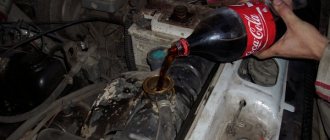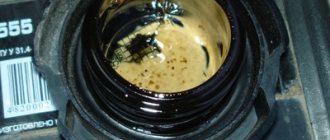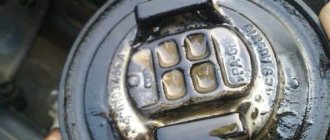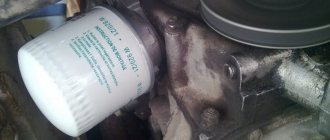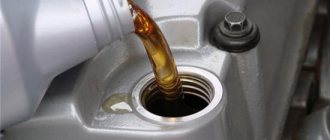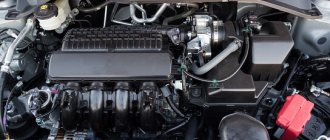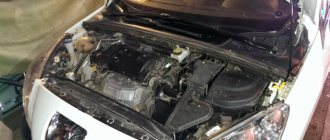If you notice that greasy oil stains, foam have appeared in the antifreeze expansion tank, or the color of the coolant has changed dramatically, you are faced with one of the popular problems that lead to oil getting into the antifreeze. During normal operation of the power unit, these fluids circulate in their closed systems in isolation from each other. But with certain technical problems, the liquids mix, forming a harmful emulsion.
Here are the main problems in which oil can mix with antifreeze:
- broken cylinder head gasket;
- worn heat exchanger gasket;
- a crack in the block or in the cylinder head;
- violation of the plane of the block head;
- failure of the heat exchanger - cracks in the housing.
Other design features of each specific engine may also be to blame.
Broken cylinder head gasket
A gasket is installed between the block and the cylinder head, which prevents fluids from mixing or entering channels not intended for them. If this gasket is worn out, deformed, or damaged, fluids will begin to flow chaotically in the engine systems and mix. This will cause an emulsion to form in the expansion tank, as well as in the engine crankcase.
Rumor has it that checking the integrity of the cylinder head gasket is very simple. They say that if white or bluish smoke does not blow from the pipe, then the gasket is normal. In fact, this is very far from reality. The gasket is quite large and can tear anywhere. For example, between two fluid circulation channels. In this case, the liquid that circulates under high pressure will flow into another liquid and form an emulsion.
Also, the gasket may tear in its outer part, due to which one of the liquids will begin to leak onto the engine housing. Therefore, the presence or absence of smoke from the exhaust pipe does not confirm anything. The condition of the fluids should be monitored to understand the condition of the cylinder head gasket in the engine.
Bent cylinder head
When overheated, engine parts can become deformed, creating additional problems for the car owner. For example, you may encounter that the plane of the block head will not be perfectly flat. A deviation of a few microns is enough to cause problems. In some places, peculiar cavities are formed, the head does not adhere well to the gasket, because of this, technical fluids begin to mix, forming an emulsion.
It is quite difficult to correct this situation. You need to remove the cylinder head and take it to the craftsmen for grinding. Of course, in this case, you should also inspect the valve system, grind the valves, inspect and possibly replace the valve seals, inspect the condition of the cylinder block and pay special attention to the condition of the oil scraper and compression rings. If they are already worn out, it is better to replace them immediately.
The block head is ground if the deformation is not too severe. Otherwise, you may need a new head or a used part from a donor.
Crack in the sleeve
If the cylinder liner is cracked, there may also be problems with a small amount of oil getting into the antifreeze. The oil will simply be squeezed out in small portions. The sleeve cannot expand to form a large hole because there is simply no room for it. Therefore, you will only see an oil film in the expansion tank.
This situation is difficult to diagnose. To find a fault, you will have to disassemble the entire engine and inspect the internal parts of the cylinder block, which takes a lot of time and requires special tools. The sleeve will have to be replaced, since there is no point in boiling it.
Heat exchanger gasket
A torn heat exchanger gasket will also be one of the reasons for oil getting into the antifreeze. The oil cooler has a fairly robust design in most cars, but on a number of engines it still often shows problems. In particular, this applies to Opel engines of 1.4, 1.6 and 1.8 with the promising abbreviation XER in the name. In general, these engines are reliable, but the heat exchanger in them quite often makes owners worry about the condition of all systems.
However, a breakdown of the heat exchanger is not the worst problem. The gasket is quite easy to change. You just need to drain the antifreeze and oil, flush the cooling system, change the gasket, add new technical fluids and move on. For the price, such repairs will also not be too unpleasant.
Replacing the gasket when eliminating a leak
To eliminate engine oil leakage into the car's coolant due to a worn gasket, you need to install a new one. For the replacement procedure, you will need distilled water, a new gasket, and new coolant.
First, you should wash the structure with a special cleaning liquid. To do this, you need to pour cleaning fluid into the cooling structure of the car and turn on the engine for the time required for the fan to start operating. Then you need to empty the system by draining the used antifreeze. Antifreeze is drained through a hole located behind the engine or radiator plugs.
The oil cooler is disassembled into its component elements. In this case, the car enthusiast should be guided by the server description for the vehicle, since the disassembly procedure depends on the specific car. After disassembly, the entire system must be thoroughly cleaned and worn gaskets replaced with new ones. Gaskets should be purchased for a specific vehicle.
Cracks in the oil cooler block
Physical damage to the heat exchanger is more difficult to repair. In most cases, you will have to purchase new parts, since argon welding is useless - soon cracks will form again and will require all fluids to be changed and repairs performed again.
But such breakdowns often occur only at very long mileage or during accidents in which there is a specific physical impact on the heat exchanger. In other cases, the oil cooler does not experience heavy loads.
How to make sure that oil has gotten into the antifreeze?
You can easily find out that your car has started to leak oil into the cooling system. To do this, just open the hood and do a few simple and standard checks.
In particular, look at these factors:
- antifreeze color - if it becomes dark, cloudy, or white, you should stop using the car and figure out the causes of the problem;
- a greasy film on the surface of the coolant - this signal indicates minimal leaks in the system, you should pay attention to this;
- the texture of the antifreeze has become oily - in its normal state, antifreeze is similar to water, but with oil impurities it will be viscous and thicker;
- burnt smell from the expansion tank - usually antifreeze does not have a pronounced odor, but if oil gets in, an unpleasant odor will appear;
- increased engine operating temperature - all systems work, but the engine overheats, since the effectiveness of antifreeze decreases with oil impurities;
- there are emulsion deposits on the expansion tank cap - this is a light coating that may foam a little;
- bubbles in the antifreeze system - bubbles indicate that there is depressurization of the system, you need to pay attention to this.
If you notice such unpleasant effects, you should immediately check the condition of the oil using a dipstick. The fact is that when oil gets into it with antifreeze, it sharply loses its properties and stops lubricating engine parts. This significantly increases the wear of rubbing parts, worsens the operating conditions of the unit and brings closer engine overhaul.
Filling with low-grade refrigerant or mixing antifreeze of different classifications
There are cases when a driver, noticing a low level of coolant in the tank, pours in the first available antifreeze. This should not be done under any circumstances! You cannot mix refrigerant that differs in composition and class.
There is a certain classification of refrigerants - g11,12,13, they all differ in cost and quality. Some people mistakenly think that you can mix antifreeze of the same color, but this is not true. The color of the coolant is given by the dye that manufacturers add there.
Additives added to antifreeze, when combining different types of antifreeze, may be incompatible and, when heated, enter into a chemical reaction, the consequences of which will be unpredictable.
Conclusion: use only products tested and recommended by car manufacturers.
What is the risk of oil getting into antifreeze?
It may seem that getting one technical fluid into another is not so dangerous. But in reality, everything can end very sadly. The fact is that fluids stop doing their job normally, reduce efficiency and generally lead to the formation of new problems in the operation of the power unit.
In particular, you may encounter the following problems:
- engine overheating - the temperature begins to rise especially quickly at high speeds;
- blockage of the engine cooling system and complete cessation of its operation in advanced cases;
- the formation of leaks in the cooling system, most of the parts of which are not oil resistant;
- significant reduction in motor life due to changes in its operating modes;
- decreased efficiency of oil cooling in the heat exchanger, constant overheating of parts.
All this can lead to deformation or destruction of some engine elements. In general, if you drive on emulsion for a long time, you will have to come to terms with the fact that you will need to overhaul the engine or even buy a new power unit. Of course, such expenses will clearly not please the car owner.
Fault detection
This problem, or rather, a serious breakdown, is quite insidious and does not appear immediately. Liquid lubricant passes through microcracks in small portions, without having a particular effect on the operation of the power unit. Changes become noticeable at the next stage, when the channel connecting the two systems expands and the mixing speed increases.
How to determine whether lubricant has gotten into antifreeze:
- due to the deterioration of the cooling properties of antifreeze, the engine begins to heat up more often, the electric fan operates more often;
- the oil level gradually decreases, and the antifreeze level increases (it’s quite difficult to notice);
- the pump impeller whips up the oil-water mixture, turning it into a thick white emulsion that clogs the filter, causing the engine lubricant pressure to drop;
- drips are visible on the outside of the block or heat exchanger body, originating near the gasket (they do not always appear);
- the oil in the expansion tank changes the color and consistency of the coolant.
Important! The most obvious sign of mixing, monitored visually, is a white emulsion in the expansion tank with antifreeze. If you find a similar substance in the tank, compare this fact with other symptoms - constant overheating of the engine and signals from the oil level warning lamp.
As a rule, trouble does not come alone. Antifreeze that gets into the oil pan can create serious problems: at best, the emulsion will clog the lubricating channels and filter. In the worst case scenario, the crankshaft will rotate the bearings (sliding bearings) as a result of oil starvation. Expensive repairs are guaranteed.
Often the gasket bursts all the way to the cylinder walls, after which antifreeze gets into the combustion chambers (its channels are closer). The sign of a breakdown is clearly visible - white smoke pours out of the exhaust pipe in large quantities, and the engine power drops sharply.
When a similar problem occurs on a machine equipped with a heat exchanger - a motor lubricant cooler, diagnostic difficulties arise. If there are no external signs in the form of drips, then after identifying the emulsion in the expansion tank, it is better to contact a car service center. There, both units will be purged with a special installation and the culprit will be determined by air leakage.
Frequently asked questions about oil in antifreeze
How to avoid oil getting into antifreeze?
Unfortunately, this is an unpredictable process. Engine parts are destroyed from the inside, but from the outside everything may look quite decent. It is important to respond to a breakdown in time and fix it.
Is it possible to drive a car if there is oil in the antifreeze?
If you see a white or black emulsion in the coolant reservoir, you cannot drive such a car; it is better to turn off the engine. If we are talking about a small oil film, you can drive a few kilometers to the service station under your own power.
What does it mean if foam comes out of the antifreeze reservoir?
This means that your car does not have antifreeze in its cooling system, but an emulsion. That is, this fluid does not perform any tasks, the engine overheats. It is also likely that the oil in the engine lubrication system has also emulsified. This is quite a big problem; you can’t drive such a car.
Do I need to flush the cooling system if oil gets into it?
Yes, washing is necessary. But first you need to eliminate the cause of the problem. Next, flush the cooling system with a suitable chemical and make sure that all hoses are intact. Only then can you add fresh antifreeze.
How to prevent a malfunction from occurring?
You can avoid breakdowns if you take into account tips and recommendations for using antifreeze. The very first rule is that you absolutely cannot add antifreeze to the tank if it is not compatible with the composition already used. It is imperative to follow all manufacturer’s recommendations regarding the materials used.
Masters advise regularly performing car maintenance work. You need to carefully monitor how the car behaves and what symptoms appear. When signs indicating a violation appear, it is necessary not to continue driving the car, but to begin repairs.
Since the repairs may require quite serious repairs, it is better to immediately contact knowledgeable people. Specialists will quickly find the leak and be able to determine the causes. The repair technicians will also be able to carry out repairs to a higher quality. The service station has the necessary equipment, and the room is suitable for repair work.
